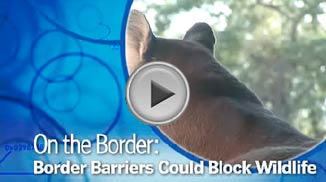Ferruginous Pygmy Owl | Discovery News Video
July 8, 2009 -- The United States-Mexico border fence may block more wildlife border crossings than people crossings. The already limited border populations of pygmy owls and bighorn sheep will likely be among those further threatened by the fence, says a new study. "In some respects, it's as obvious as the nose on your face: If you put up a 20-foot chunk of steel, things probably aren't going to move across it, but we have to show it," said Paul Beier of Northern Arizona University in Flagstaff, who was not a part of the study. "It's kind of a shame that we need to prove the obvious, but we do. So this is an important paper in that regard." Since the U.S. government authorized construction of a fence along 700 miles of the border between the U.S. and Mexico in 2006, scientists have raised concerns that a person-tight fence would also exclude many species that rely on habitat on either side of the border. The new research suggests such concerns are valid. "Borders are only political boundaries," said the study's lead author Aaron Flesch of the University of Montana in Missoula. "They're not biological boundaries." The study, published recently in Conservation Biology, focused on desert bighorn sheep and ferruginous pygmy owls. By combining information about bighorn populations along the Arizona-Mexico border with computer models, the study's coauthor Clinton Epps of Oregon State University was able to predict the effect of the fence on how sheep move from one group to another. Epps found nine populations within his study area that would become isolated from populations across the border. What's more, two populations on the U.S. side of the fence rely on a path that dips through Mexico, so they would become isolated from one another, despite both being "American" bighorn. Related Content:
"The ability to move between mountain ranges is pretty important to maintain genetic diversity," Epps said, "But probably more importantly, the populations are so small, that they can just wink out." Without cross border connections, the habitats couldn't be repopulated by sheep in nearby groups. The pygmy owl seems an unlikely species to be blocked by a border fence, given that it can fly. But the team found that 80 percent of the owls' flights are less than 13 feet above the ground, with most of those less than 3 feet above the ground. What's more, the owl tends to make short, direct flights, avoiding stretches across open areas such as the zones of cleared vegetation on either side of the fence. "Their survival in Arizona is probably dependent on movement from Mexico into the U.S.," said Flesch, who conducted the owl study. "That's why a 700-mile-long border fence is so relevant to their recovery and the recovery of so many other animals." Jaguars, desert tortoise, wild turkeys, bears, and Sonoran pronghorn are among other species that may be affected by the border fence. Flesch and others support using virtual fences instead of physical barriers along the border, especially in critical habitat areas. Surveillance technology could allow wildlife to pass freely, while still catching illegal traffic across the border, they propose. Some vehicle barriers -- vertical posts close enough together to stop cars or trucks, but not so close as to block people or wildlife -- could also be used with less obstruction of wildlife movement. The border fence is all the more significant in today's warming climate, Flesch noted. The border happens to fall at a boundary between two climates, so many species will tend to nudge their range north as climate warms. If they are blocked by the fence, their habitat may leave them behind. Related Links: Ads by Google
|
advertisement
06 Nov
06 Nov
06 Nov
06 Nov
06 Nov
05 Nov
05 Nov
05 Nov
05 Nov
05 Nov
|






















